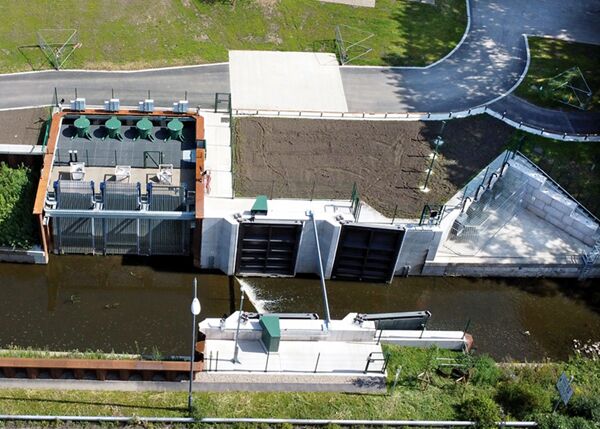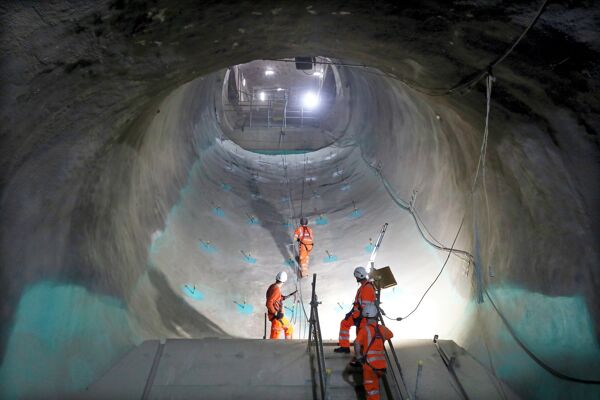
NEC contracts were used to procure most of the infrastructure and systems for the £19 billion Elizabeth line in London, one of the biggest and most challenging civil engineering projects undertaken in Europe this century. The 118 km long line was officially opened by Queen Elizabeth II in May 2022 and it will be fully operational in May 2023.
In the first year of operation, ridership levels reached 600,000 journeys a day, making it one of the UK’s busiest railways. It is also one of the most reliable, achieving an industry performance rating of 93% and very high customer satisfaction levels. In May 2023, service levels will rise from 22 to 24 nine-car electric trains per hour in each direction during peak times, achieving the targeted 10% capacity increase for central London’s rail network.
The new railway runs across the capital via upgraded existing surface routes and a new central tunneled section, making a direct link between Reading and Heathrow airport in the west and Shenfield and Abbey Wood in the east. It has 41 stations including 10 new stations in central London, eight of which are underground, and 42 km of new 6.2 m diameter tunnels up to 42 m deep. Over 55,000 jobs were created during construction.
NEC used throughout
Work officially started in 2009 when client Crossrail Limited was created as a subsidiary of Transport for London (TfL) and jointly sponsored by the Department for Transport. Previous design activities were transferred to 12 new design framework agreements based on the NEC3 Framework Contract (FC), and package orders were let using the NEC3 Professional Services Contract (PSC). Programme partner Transcend − a joint venture of Aecom, CH2M Hill and Nichols Group − and delivery partner Bechtel were also initially engaged under NEC3 PSC.
A total of 22 enabling works frameworks were awarded at the same time, again under NEC3 FC but with package orders mostly let using NEC3 Engineering Construction Contract (ECC) Option A (priced contract with activity schedule).
In 2010 Crossrail started awarding the 36 main works contracts, with 33 let as NEC3 ECC Option C (target contract with activity schedule) featuring a 50:50 pain-gain share. These included five major tunnel and shaft contracts requiring eight tunnel boring machines; 14 separate station contracts; and five project-wide railway systems packages.
The contracts for marine transport of 7 Mt of tunnel spoil for re-use was let under NEC3 ECC Option B (priced contract with bill of quantities), while a temporary receiving jetty at Wallasea island in the Thames estuary and platform screen doors were awarded under NEC3 ECC Option A. Some ECC Option C contracts were later renegotiated to incentivise performance, including the use of programme incentive payments.
Fair allocation of risk
David Morrice, delivery contracts director from 2010 to 2018, and Megan Hands, project solicitor from 2007 to 2018, describe the use of NEC contracts in detail in two Crossrail Learning Legacy papers (Morrice and Hands, 2017; Hands and Morrice, 2018).
They say there were several reasons for selecting NEC. ‘It was considered to be supportive of Crossrail’s culture and objectives; it should achieve a fair and sensible allocation of risk; it would provide robust contract management processes; it could be used for all Crossrail requirements (by providing a variety of procurement options); it was endorsed by the Office for Government Commerce, TfL and the Institution of Civil Engineers; and its use on other major projects such as London 2012 and High Speed One would provide the opportunity to benefit from lessons learned.’
They reported that by January 2017, 19 of the 36 contracts had reached formal contract completion, all of which were also commercially settled and with no outstanding disputes. They concluded, ‘With the NEC3 ECC Option C, Crossrail Limited has had full visibility of contractors’ actual costs, which is a great benefit when seeking to settle disputes.’ All NEC contracts used project bank accounts and those over 3 years duration included option X1 on price adjustment for inflation.
In May 2022, Jim Crawford, chief programme officer from 2020 to 2022, said, ‘We are delighted that the transformational Elizabeth line is now open with hundreds of thousands of customers making fast and seamless journeys through the heart of London. Crossrail Ltd used an NEC model for the majority of design and construction contracts, which encouraged a collaborative relationship between the client and contractors.’
Benefits of NEC
- NEC contracts supported the client’s culture and objectives encouraged a collaborative relationship between the client and contractors.
- NEC and achieved a fair and sensible allocation of risk and provided robust contract management processes.
- NEC’s wide variety of procurement options enabled it to be used for all project requirements, from design and enabling frameworks to main civil engineering and rail systems packages.
- ECC Option C gave the client full visibility of contractors’ actual costs, which was a great benefit when seeking to settle disputes.
- Most main works contracts were commercially settled shortly after completion.
References
- Morrice D and Hands M (2017) Crossrail project: commercial aspects of works contracts for London’s Elizabeth line, Proceedings of the Institution of Civil Engineers – Civil Engineering CE6: 42-47
- Hands M and Morrice D (2018) Crossrail approach to NEC3, Crossrail Learning Legacy website, https://learninglegacy.crossrail.co.uk/documents/crossrail-approach-to-nec3



